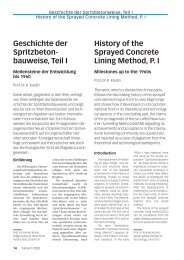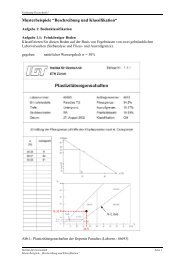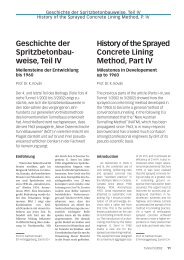Modified Bentonite Slurries for Slurry Shields in Highly ... - ETH - IGT
Modified Bentonite Slurries for Slurry Shields in Highly ... - ETH - IGT
Modified Bentonite Slurries for Slurry Shields in Highly ... - ETH - IGT
Create successful ePaper yourself
Turn your PDF publications into a flip-book with our unique Google optimized e-Paper software.
2 SLURRY SHIELD M<strong>ETH</strong>OD<br />
2.1 Excavation Procedure<br />
Tunnels <strong>in</strong> unstable ground below the groundwater<br />
table are often excavated by the closed-type<br />
shield method. If the stand-up time of the face is<br />
short or even vanish<strong>in</strong>g, the face must be supported,<br />
<strong>in</strong> the case of a slurry shield by a suspension under<br />
pressure.<br />
The suspension is pumped <strong>in</strong>to the so called<br />
work<strong>in</strong>g chamber (Fig. 3), where it is put under<br />
pressure by compressed air. The effective support<br />
pressure depends on the pressure of the compressed<br />
air, the density of the suspension, the ability to <strong>for</strong>m<br />
a membrane or cake of low permeability, and the<br />
penetration distance of the suspension <strong>in</strong> the ground.<br />
The support pressure must be high enough to withstand<br />
the earth and water pressure at the face.<br />
called filter cake. Tak<strong>in</strong>g <strong>in</strong>to account that dur<strong>in</strong>g<br />
excavation the cutt<strong>in</strong>g wheel may rotate several<br />
times per m<strong>in</strong>ute, the existence of a filter cake is not<br />
likely. However, be<strong>for</strong>e access<strong>in</strong>g the work<strong>in</strong>g<br />
chamber under unfavorable compressed air conditions,<br />
usually it is aimed to let a filter cake be built<br />
up. In both cases, i.e. with an impermeable membrane<br />
or a filter cake, the pressure of the suspension<br />
takes effect immediately at the excavation surface,<br />
where it may be taken <strong>in</strong>to account <strong>for</strong> stability <strong>in</strong>vestigations.<br />
If the suspension penetrates the ground, the difference<br />
between the pressure of the suspension and<br />
the groundwater is gradually transferred to the<br />
ground, either from gra<strong>in</strong> to gra<strong>in</strong> or by adhesion.<br />
The body <strong>for</strong>ces beyond a potential slid<strong>in</strong>g face do<br />
not contribute any more to the stability, i.e. the effective<br />
pressure of the suspension depends on the<br />
actual penetration distance, which aga<strong>in</strong> depends on<br />
the pressure conditions, the properties of the soil and<br />
the suspension, and the advance rate. Observations<br />
dur<strong>in</strong>g physical access to the face at the Hermetschloo<br />
site showed that a small filter cake had<br />
been <strong>for</strong>med, and that the suspension only penetrated<br />
some centimeters <strong>in</strong>to the ground.<br />
Further exposition of the subject may be found <strong>in</strong><br />
Fritz and Tandler (1999).<br />
3 BENTONITE SLURRIES<br />
Fig. 3<br />
<strong>Slurry</strong> Shield at Hermetschloo Site<br />
Besides the stabiliz<strong>in</strong>g effect of the suspension, it<br />
serves also as a means <strong>for</strong> transport<strong>in</strong>g the excavated<br />
soil, which is mixed with the slurry.<br />
The two chamber design of a suspension shield is<br />
very flexible <strong>for</strong> <strong>in</strong>spection and repair works. By<br />
simply vary<strong>in</strong>g the pressure of the compressed air<br />
the level of the suspension <strong>in</strong> the work<strong>in</strong>g chamber<br />
may gradually be varied without hav<strong>in</strong>g to undertake<br />
any other measures. At the same time the work<strong>in</strong>g<br />
chamber may be set under compressed air, which<br />
ma<strong>in</strong>ta<strong>in</strong>s the necessary support pressure. Under<br />
these conditions access to the work<strong>in</strong>g chamber is<br />
possible.<br />
2.2 Mode of Action of the Suspension<br />
Depend<strong>in</strong>g on the porosity of the soil, the excavation<br />
surface may act as a filtration area <strong>for</strong> the<br />
suspension, and a th<strong>in</strong> nearly impermeable membrane<br />
may be <strong>for</strong>med. If there is enough time available,<br />
a secondary filtration on the membrane may<br />
take place, which leads to the <strong>for</strong>mation of a so<br />
3.1 Composition of <strong>Bentonite</strong><br />
Much experience is available <strong>for</strong> bentonite slurries,<br />
not only from slurry shields, but even more so<br />
<strong>for</strong> diaphragm walls and the drill<strong>in</strong>g <strong>in</strong>dustry. <strong>Bentonite</strong><br />
is a type of clay that is <strong>for</strong>med by weather<strong>in</strong>g<br />
of volcanic ash. It consists ma<strong>in</strong>ly of the clay m<strong>in</strong>eral<br />
montmorillonite. Montmorillonite is assigned to<br />
the smectites and is a 3 layer clay m<strong>in</strong>eral, consist<strong>in</strong>g<br />
of two silicon tetrahedron layers and one alum<strong>in</strong>ium<br />
octahedron layer. In the octahedron layer,<br />
trivalent alum<strong>in</strong>ium ions are partly substituted by<br />
divalent magnesium ions, lead<strong>in</strong>g to a negative<br />
charge on the surface of the layers. This negative<br />
surplus charge is responsible <strong>for</strong> the capability of<br />
cation exchange (adsorption of Na- or Ca-cations).<br />
Depend<strong>in</strong>g on the type of the adsorbed ions, the<br />
bentonite is designated as Na- or Ca-bentonite.<br />
When water is available, the cations can hydrate<br />
and the distance between the layer packs will widen;<br />
this is called <strong>in</strong>ner crystall<strong>in</strong>e swell<strong>in</strong>g, a typical<br />
property of montmorillonite or bentonite. The absorption<br />
of water and thus the swell<strong>in</strong>g is higher <strong>for</strong><br />
Na-bentonites than <strong>for</strong> Ca-bentonites, as the Na-ions<br />
hydrate more easily when adsorbed.






